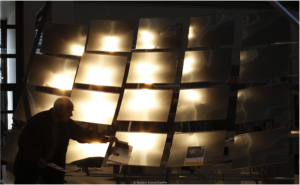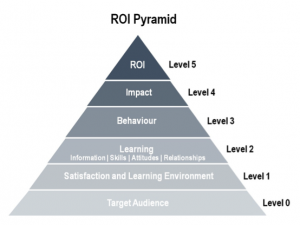Trade show technology may improve the quality of visitors or the visitor experience before, during and after the show, to the benefit of the main stakeholder, the exhibitor. But the technology comes with a cost and the added benefit to the exhibitor must be greater than the cost.
By Elling Hamso and Rosa Garriga Mora, Event ROI Institute
Suppliers exhibit at trade shows to meet potential customers and turn them into business. The net value of that business has to be greater than the cost of exhibiting, or the exercise returns a loss, the Return on Investment (ROI) is negative. If the profit generated from the show is twice the cost, the money is doubled, ROI is 100%. Profit and ROI is the same thing, the same result expressed as a money value or a percentage.
The challenge for every exhibitor is to maximise sales as a result of the show whilst keeping costs as low as possible. Or if costs increase, profit from sales have to increase by an even greater amount.
This is the simple formulae faced by trade show organisers when contemplating the cost of new technology to improve exhibitor ROI.
One example of exhibition technology allows for pre-scheduled appointments (PSA) between exhibitors and visitors. On its own, the PSA tool makes the visitor study exhibitor offerings in advance and book a vacant slot in the appointment calendar. Instead of randomly browsing the exhibition floor and hoping there will be a qualified staff member free to talk at any exhibits of interest, the visitor is now on a preplanned and more purposeful journey. The exhibitor has a calendar of appointments with visitors who take a considered interest in his products or services.
Taken one big step further, the trade show organiser will host qualified buyers, paying for their travel and accommodation, ensuring that the exhibitor diary is filled with high quality appointments. In return for being hosted, the buyer has to undertake a minimum number of pre-scheduled appointments.
Whereas the cost of simply making a PSA system available to exhibitors and visitors is limited and may not have a big bearing on the fee charged to exhibitors, a hosted buyer programme means significantly higher costs to the exhibitor.
How does the exhibitor know that it is worth the extra money?
 The quality of leads will obviously be higher when carefully selected buyers have been hosted to attend the exhibition, but how much more purchase value will they generate for the exhibitor?
The quality of leads will obviously be higher when carefully selected buyers have been hosted to attend the exhibition, but how much more purchase value will they generate for the exhibitor?
The only way to find out is for exhibitors to measure their return on investment from trade show participantion. How do they do that?
The ROI Methodology
The fundamental principle of value generation from trade shows is that participants have to do something as a result of their visit which in one way or another provides value to the exhibitor. The visitor may go away from the boot feeling impressed, educated and inspired, but if he takes no action which is different from what he would otherwise have done, there is no value to the exhibitor. Thinking and feeling creates no value, only actions can lead to more sales.
The most obvious action is to go back to the office and sign a purchase order, but it usually isn’t as simple as that. Take a motor show for example. Car manufacturers exhibit their new models to attract distributors, fleet buyers, individual buyers or fleet car users, journalists, just to mention some of the main categories of visitors. What specifically does the exhibitor want representatives from each of these visitor categories to do as a result of spending some time at their booth?
Let us just consider the individual customer, a memer of the public who contemplates buying a new car. He is in the target segment of our imaginary exhibitor who has a 20% market share in this segment. Statistically, one in five will become a customer, the probability of purchase is 20%. But our exhibitor knows that if he can get a target customer to test drive the new model, 40% of those who do so end up buying the car. So from past experience, statistics or estimations, the seller knows that a test drive increases the probability of purchase by 20 percentage points. Let us say that the average profit on the sale of a car is $1000, one extra test drive as a result of the exhibition is statistically worth $200. By tracking test drives caused by exhibition visits (and nothing else), the exhibitor is able to calculate the monetary business impact.
For each category of visitors there will be different calls to action. The journalists should write favourable reviews, the fleet car driver should request from his company a particular car model, the fleet buyer should compare life of ownership costs with competitors, etc.
This list of specific behaviours required from every category of visitors should be the starting point for anyone planning their presence at a trade show.
The next planning step is obvious; what does the visitor need to experience at the stand in order to do what is required. The stand experience is always a learning experience, learning new information, skills or attitudes or learning to know new people, such as an exhibitor representative who will follow up the potential new relationship.
When the learning experience which leads to the desired behaviour has been defined, the exhibitor is ready to plan the visitor experience at his stand. The physical environment, staff, scripts, displays, etc. This is what we call the learning environment, usually what the visitor will refer to when expressing his satisfaction or otherwise with the visit.
When the exhibitor has planned the visitor experience to achieve the desired behaviour, only one thing remains; a large number of high quality visitors, and this is where the technology of pre-scheduled appointments fits into the picture. How many high quality visitors can be taken through the stand experience resulting in the behaviour change which provides value in return to the exhibitor.
Some exhibitors have worked systematically for years categorising and documenting stand visitors, measuring their learning experience at the stand through on-site interviews or post visit questionnaires, and tracing subsequent purchase behaviour or other behaviour which increases the probability of purchase by a known amount.
For these exhibitors, who have a reliable estimate for the sales value of a visitor, the value of a PSA system is easily derived from comparing the number of qualified visitors to the stand. For everyone else, there is no way of knowing without starting to measure.
Measurement is a step-by-step process and not as difficult as it may seem. The steps of objectives and measurement are illustrated by the ROI pyramid.
Objectives are first set at the top, what profit, or return on investment, do we require from the exhibit, what amount of sales will generate the necessary value, we call this the Impact value, what behaviour will lead to the sales, what learning will cause the behaviour, what environment will facilitate learning and how many qualified visitors do we need.
Measurement always start from the bottom of the pyramid and moves step-by-step towards the top. The numbers and categories of visitors are easily recorded at Level 0 – Target Audience. Level 1 – Satisfaction and Learning Environment is easily measured by asking the visitors, on site or afterwards. Level 2 – Learning data is also easy to collect if we accept the self reporting of visitors as sufficient. Level 3 – Behaviour is typically measured by questionnaires and self reporting, but we have to leave a period of time for behaviour to take place, maybe 2 – 3 months. Level 4 – Impact, is the value of sales which should be readily available from company records. In order to make the final ROI calculation we need to know the costs of trade show participation, not forgetting the cost of staff time for both planning and participating at the show.
One final issue remains, we call it isolating the effect of the event. If we measure a sales increase as a result of the trade show, we have to consider other factors which could have had an impact on sales. If a trade show visitor made a purchase, what is the likelihood of the purchase happening without the influence of the trade show. There are several techniques of isolation, the best is a control group experiment, but there are simpler and cheaper alternatives as well.
Conclusion
There is no quick fix which enables the exhibitor to judge the value of new technology, or anything else adding to the cost of trade show participation with an anticipated increase in value. Measuring the value created is the only way. Fortunately there is an industry standard method, simply calle the ROI Methodology, which has been developed over many years and comes with a full box of tools for setting appropriate objectives at six levels and collecting the data and analysing the results.
Dr. Elling Hamso is a Meeting Management Consultant and Managing Partner of Event ROI Institute. He writes and speaks frequently on subjects like ROI, Meeting Architecture, Supply Chain Management, Risk Management, and Meeting with the Millennium generation. You may write to him on elling.hamso@eventroi.org or visit www.eventroi.org.
Rosa Garriga Mora combines her work as trainer and ROI consultant with different projects related to meeting design. Working with clients from Europe and the United States, she researches and implements solutions to create more effective meetings, from speaker coaching to the use of interactive meeting formats. Contact details: rosa.garriga@eventroi.org
[purchase_link id=”3476″ style=”button” color=”red” text=”Download”]


Write more, thats all I have to say. Literally, it seems as though you
relied on the video to make your point. You obviously know what youre talking about, why throw away your intelligence on just posting videos to your weblog when you could be giving us something informative to read?
Hi, did you download the whitepaper? It provides a lot of information about the methodology and how we help small to large-scale organizations to proving the value of their events with this strategic and systematic approach. We just updated our homepage with whitepaper, case studies and more but let us know where we can improve. Bye, Ilka
WOW just what I was searching for. Came here by searching for event value measurement and event ROI Methodology
Let us know if you need more details about this methodology and strategic approach to measure your event value. We are available on email, Skype or phone – see Contact us. Bye; Ilka
Hello i am kavin, its my first time to commenting anyplace, when i
read this article i thought i could also make comment due to this brilliant post.
Hi Kevin, thank you for your feedback. Let us know if you need any additional information about this article or about Proving the value of meetings and events in general. Bye, Ilka